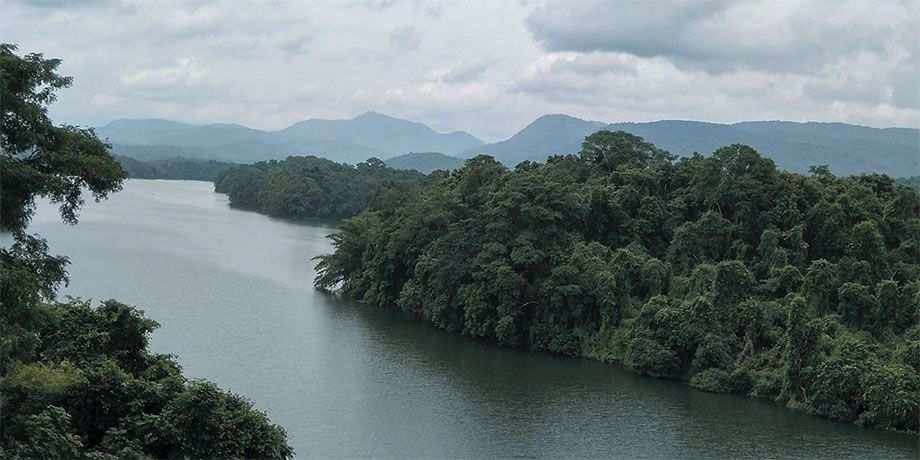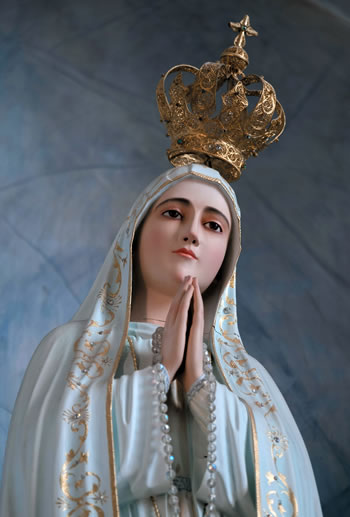
It is some four years since I last visited Saliadrau. When I left, some asked me to get them a statue of Our Lady of Fatima. This past summer when in Ireland, the Fatima statue appeared.
When in Ireland, I minister at weekends in my home parish of Macroom, the capital of Muskerry. I was raised and ordained there in 1971 by Bishop John Ahern of Cloyne. Surrounded by relatives, friends and classmates, it is always a very joyful experience of ministry for me. A friend and fellow member of the Marian Movement of Priests in Macroom (a few years behind me in school) asked if I would care for a statue he had brought back from Fatima recently. Would I ever! And so, the Saliadrau statue came into my possession.
 Traveling halfway around the world with a statue would not be a problem now that we have planes to do all the hard work.
Traveling halfway around the world with a statue would not be a problem now that we have planes to do all the hard work.
The Parish Priest of Namosi and my former student, Fr. Rogasiano Raikivi, in whose parish lies Saliadrau was keen for me to take the last Sunday Mass of 2024. I left Suva at 7 a.m. with Bill Rogoiwaqa, my frequent MMP travelling companion. After forty minutes, we left the tar-sealed road and headed into the highest mountains on our island, Viti Levu, on a dirt road. It was well kept and did not present a grave problem even on the very steep gradients.
We arrived at Saliadrau shortly after 9 a.m. The crossing took about half an hour and this part needed some preparation. I had donned my swimming shorts that morning under my trousers and had brought a knapsack with me. So, removing my shoes but keeping on my two pairs of socks to enable me to navigate the stones, wearing a sulu (Fijian cotton skirt) over my shorts, I took to the river. Lots of rain recently meant that it was much more swollen this time.
Shortly after entering the river, a Catholic from a neighboring village, who was also on his way to Mass, identified himself as Farasiko (Francis) Koroimara and took charge of me to make sure I made it across safely. Replacing our wet socks with dry shoes, and trying to regain some semblance of dignity, we then negotiated through the village to the Catechist’s house, where we were able to dry off and prepare for Mass.
The Mass started on time at 10 a.m. with their new statue as part of the procession. They had already had their Christmas Confessions so this visit did not involve the sacrament of Reconciliation, the exercise of the key of the Blood.
As always in Fiji, the Mass was sung by the entire congregation. It was Holy Family Sunday. As we are now into the Year of Luke, the Gospel was that of the Fifth Joyful Mystery of the Rosary, the finding of Jesus in the temple. The total relaxation of Mary and Joseph about Jesus’ whereabouts shows a marvelous unity between them, as did the search. They lost Jesus! I asked all in Saliadrau to pray that they would never lose Jesus.
Then, of course, we have the very first words of Jesus in Luke’s gospel. His last words in this Gospel were spoken on the cross, “Father, into your hands, I commit my Spirit” (Lk 23:46). This was from Ps 31:6, a psalm for evening and sleep. This is how the popular night prayer, “Jesus, Mary and Joseph, I give you my heart and my soul” also ends. Jesus’ first words are “Why did you seek me? Did you not know I must be about my Father’s business.” Here Jesus clearly tells us two things: He is God’s son and must do God’s will.
Later in Luke’s Gospel whenever Jesus uses the “must” word, He is referring to His coming death and resurrection. Poor Mary and Joseph obviously did not get that nuance and so the text tells us that they did not understand the “word” He spoke to them. Then He returned to Nazareth and obeyed them. A lesson for children.
After Mass, I stayed on and did a cenacle (rosary, prayer for Pope Francis and Act of Consecration to Mary) in the chapel. This was followed by a delicious lunch of chicken and taro (the Fijian potato). Usually straight after Mass, the community offers the visiting priest a “Sevusevu,” a Fijian offering of Kava by way of thanks. The rosary seems to have knocked this out but straight after lunch (eaten sitting on the ground) several elders arrived with a Tanoa, the official bowl used for Kava, and the Sevusevu took place.
After about an hour, I was offered some pillows and invited to rest. I did so and had a delightful short sleep on the matted floor that set me up for the return journey, having to negotiate, needless to mention, the river once more.
The codicil was two days on a drip in the hospital. I suspect it was the Saliadrau river water in the Kava that did me in, but who knows? All part of the bargain in the peregrinari pro Christo, the pilgrimage for Christ. This was my first pilgrimage for the Holy Year.
Columban Fr. Frank Hoare lives and works in Fiji.